GSTR 2 : Return Filing, Format, Eligibility & Rules
GSTR-2 is a monthly return that allows the taxpayer to declare and summarise the details of inward purchases of taxable goods and/or services.
However, the GSTR-2 form is currently suspended since September 2017 through amendment to the CGST Rules. In its place, GSTR-3B which is a return in a combined version of GSTR-2 and GSTR-3, is in use. For details about GSTR-3B, read our article “All about GSTR-3B return”
In this article, we discuss the various aspects of the erstwhile form GSTR-2.
About GSTR-2 and its importance
Until August 2017, every registered taxable person under GST was required to give details of inward supplies, i.e., purchases and Input Tax Credit (ITC) for every tax period in the form GSTR-2.
GSTR-2 contains details of all the purchases transactions of a registered dealer for a month. It also includes purchases on which reverse charge applies. The GSTR-2 filed by a registered dealer would have been used by the government to check with the sellers’ GSTR-1 for buyer-seller reconciliation.
However, since it is currently not in use from September 2017 tax period onwards, it has lost its significance. Instead, the taxpayers must report their eligible ITC in the form GSTR-3B while checking with their GSTR-2B and GSTR-2A.
What is buyer-seller reconciliation?
Buyer-seller reconciliation or invoice matching or is a process of matching taxable sales by the seller with the taxable purchases of the buyer. It is vital because ITC on purchases will only be available if the details of purchases filed in GSTR-2 (currently in GSTR-3B) return of buyer matches with the details of sales filed in GSTR-1 of their seller.
For example, Ajay buys 100 pens worth Rs. 500 from Vijay Stationery. Vijay Stationery must show Rs. 500 sales in his GSTR-1. Ajay must show the same Rs. 500 purchase in GSTR-2 (currently GSTR-3B) to claim ITC. Unless the amounts match, Ajay will not be able to claim ITC.
At present, this reconciliation or matching is done between GSTR-2B and GSTR-3B. Sometimes, the taxpayer may have to refer to the GSTR-2A.
Most of the headings under GSTR-2 are auto-populated from counterparties’ GSTR-1, so it would have involved minimal time.
When was GSTR 2 due for a month?
As per the Act, the due date for filing GSTR-2 is 15th of next month. There was a 5-day gap between GSTR-1 & GSTR-2 filing given to correct any errors and discrepancies. However, the due date for businesses filing returns on a quarterly basis was never announced.
What happened if GSTR-2 was not filed?
If GSTR-2 return is not filed then the next return in form GSTR-3 (currently GSTR-3B) could not have been filed. Hence, late filing of GST returns have a cascading effect leading to heavy fines and penalty.
However, currently GSTR-2 and GSTR-3 both are suspended since September 2017.
If one delays the filing, he/she would have been liable to pay interest and a late fee. Interest is 18% per annum. It had to be calculated by the taxpayer on the amount of outstanding tax to be paid. The time period was from the next day of filing (16th of the next month) up to the date of payment. The late fee would have been Rs. 100 per day per Act. So, it is Rs.100 under CGST & Rs.100 under SGST. Total will be Rs. 200/day. The maximum is Rs. 5,000.There is no late fee for IGST.
Who should file GSTR-2?
Every registered person was required to file GSTR-2 irrespective of whether there are any transactions during the month or not. However, these registered persons do not have to file GSTR 2 as per GST law –
- Input Service Distributors
- Composition Dealers
- Non-resident taxable person
- Persons liable to collect TCS
- Persons liable to deduct TDS
- Suppliers of online information and database access or retrieval services (OIDAR), who have to pay tax themselves (as per Section 14 of the IGST Act)
How to revise GSTR 2?
GSTR 2 once filed cannot be revised. Any mistake made in the return can be revised in the next month’s return. It means that if a mistake is made in GSTR 2 of July 2017, rectification for the same can be made in the GSTR 2 of August 2017.
What is GSTR-2A?
When a seller files his GSTR-1, the information is captured in GSTR-2A. GSTR-2A is a purchase-related tax return that is automatically generated for each business by the GST portal. It takes information from every seller’s GSTR-1 for a particular buyer registered under GST. The return is dynamic in nature and can vary with changes or revisions done by sellers in later tax periods. So, GSTR-2B return was introduced.
What is GSTR-2B?
GSTR-2B is a new static auto-drafted statement for regular taxpayers. It is available month wise and was introduced on the GST portal from the August 2020 tax period onwards. The details of ITC in this return does not get altered for a particular tax period, even if the seller makes revisions. Hence, the taxpayers can refer to the ITC appearing in this return for eligible ITC claims in GSTR-3B for a tax period.
Contents of the form GSTR-2
There are 13 headings in GSTR-2 format prescribed by the government. Each heading is explained here along with the details required to be reported under GSTR-2.
1.GSTIN – Each taxpayer will be allotted a state-wise PAN-based 15-digit Goods and Services Taxpayer Identification Number (GSTIN). A format of proposed GSTIN has been shown in the image below. GSTIN of the taxpayer will be auto-populated at the time of return filing.

2.Name of the Taxpayer – Name of the taxpayer including legal and trade name (will be auto-populated)Month, Year – Mention the relevant month and year for which GSTR-2 is being filed.

3.Inward Supplies from Registered Taxable Person – Most of the purchases from a registered person will be auto-populated here from GSTR-1 filed by the seller. It will have all details of type, rate and amount of GST, whether ITC is eligible, amount of ITC. However, it will not contain purchases under reverse charge
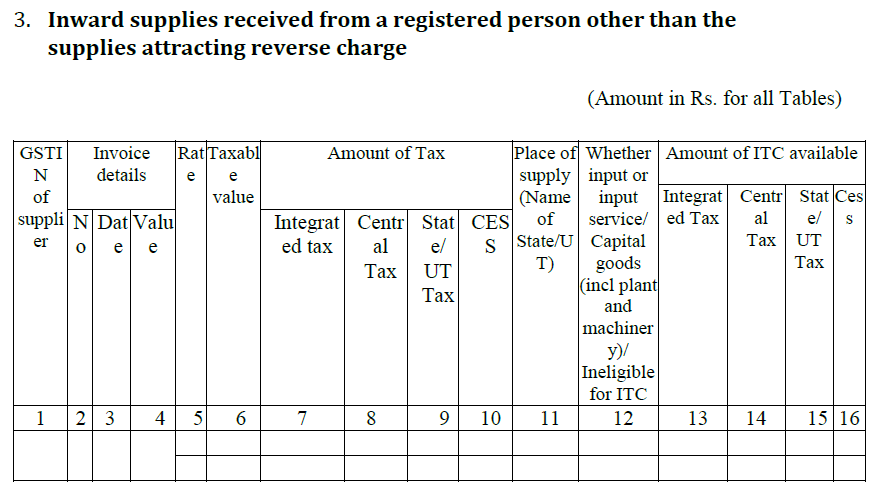
Certain transactions may not be auto-populated because-
- Seller did not file GSTR-1
- Seller filed GSTR-1 but he missed the transaction
In either case, the buyer can manually add these transactions. The seller will get a notification to accept this addition/modification in his GSTR-1A return. If the supply is received in more than one lot, the invoice must be reported in the return of the month in which the last lot is received and recorded in books of accounts.
4.Inward supplies on which tax is to be paid on reverse charge –
Certain goods and services attract reverse charge, i.e., the buyer is liable to pay GST. A registered dealer purchasing more than Rs. 5,000 per day from an unregistered dealer is liable to pay reverse charge. All purchases on which reverse charge applies, will be reported in this part.
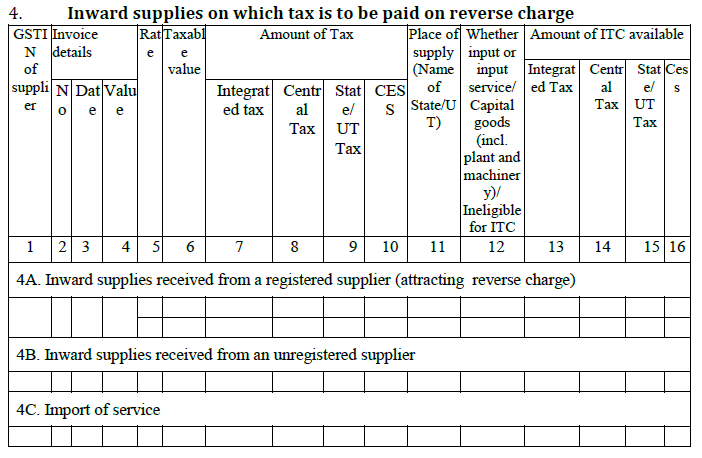
4A. Under this head, all purchases on which reverse charge specifically applies by law must be mentioned. For example, purchasing cashew nuts from an agriculturist. 4B. This head will list the purchases from unregistered dealers which exceed Rs. 5,000 per day from an unregistered dealer 4C. Under this head, reverse charge GST paid on import of service will be reported.
5.Inputs/Capital goods received from Overseas or from SEZ units on a Bill of Entry –
Any kind of import of inputs (items used to manufacture finished goods) or capital goods received against a Bill of Entry must be reported under this head. Goods received from SEZ are also reported here.
- 5A. Imports: Any kind of import of inputs (items used to manufacture finished goods) or capital goods received against a Bill of Entry will be reported here. Details of bills of entry, along with 6-digit port codes and 7-digit bill numbers must be mentioned.
- 5B. Received from SEZ: Inputs or capital goods received from sellers in a SEZ will be reported here.
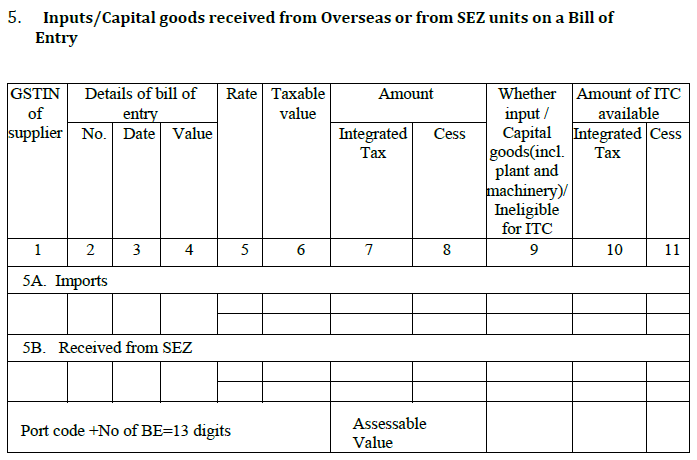
6.Amendments to details of inward supplies furnished in returns for earlier tax periods in Tables 3, 4 and 5 [including debit notes/credit notes issued and their subsequent amendments] –
A taxpayer cannot revise any GST return once it is filed. Revision is possible only in the next month’s return under this heading. The taxpayer can amend any detail of purchases of goods/services in earlier months. This information can be filled manually. Subsequently, the seller will also get a notification regarding this modification. The seller needs to accept this change in his GSTR-1A return.
6A. This head will contain all revisions of input goods/services (except imports)
6B. Any change in amount/tax calculated on imported goods and goods from SEZ can be made under this heading. Here, the taxpayer must mention the changes made in the bill of Entry / Import Report.
6C. The taxpayer must report all debit and credit notes issued with respect to purchases. Any debit/credit note issued under reverse charge mechanism will get auto-populated here from counter-party GSTR-1 and other applicable returns (eg. GSTR-5 filed by NR).
6D. Any changes in debit /credit note of previous months will be reported under this heading.

7.Supplies received from composition taxable person and other exempt/Nil rated/Non-GST supplies received –
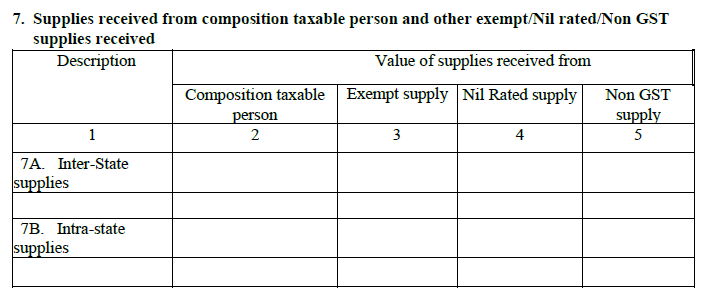
This head will include purchases from composition dealers and other exempt/nil/non-GST supplies. Non-GST supplies include items like petrol, diesel which are not covered under GST. Also, both inter-state and intra-state supplies need to be reported here.
8.ISD credit received –
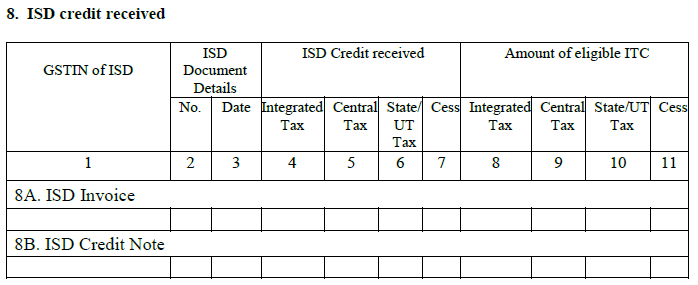
Details of the input tax credit received from a registered Input Service Distributor (ISD) (usually a head office which has transferred its ITC to all its branches). This data will be auto-populated from GSTR-6 filed by ISD.
9.TDS and TCS Credit received –
TDS Credit Received – This section will only be applicable in case you engage in specified contracts with specified persons (usually government bodies). The receiver (government) will deduct a certain percentage of transaction value as Tax Deduction at Source. All information will get auto-populated here from GSTR-7 filed by the deductor.
TCS Credit Received – This heading is applicable for only online sellers registered with e-commerce operator. E-commerce operator is required to collect tax at source at the time of making payment to such sellers. This information will again be auto-populated from GSTR-8 of e-commerce operators. Please read our Impact Analysis on E-commerce marketplace sellers for more information.
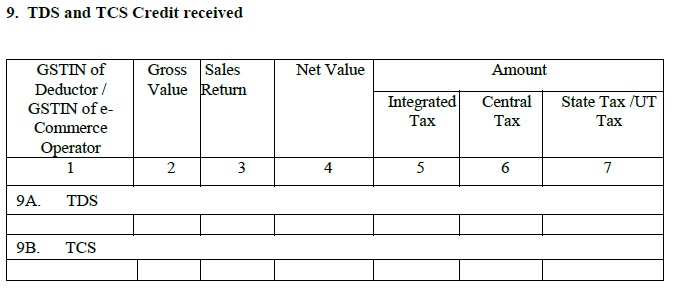
10.Consolidated Statement of Advances paid/Advance adjusted on account of receipt of supply –
Any advance payment made during the month will appear here. If you paid advance tax on goods or services received during an earlier tax period, but only received the invoices this month, declare the details here. Advance receipts issued under reverse charge are also covered here.
Normally the seller issues an advance receipt when he receives any advance payment. In case of purchases attracting reverse charge, the buyer must issue the advance receipt if he pays in advance.
Part I –
- This part will cover the advance amount paid for reverse charge supplies in the current month.
- It will also include the advances paid in earlier months against which invoices have been received in current month.
- The purchases will be broken up into inter-state and intra-state.
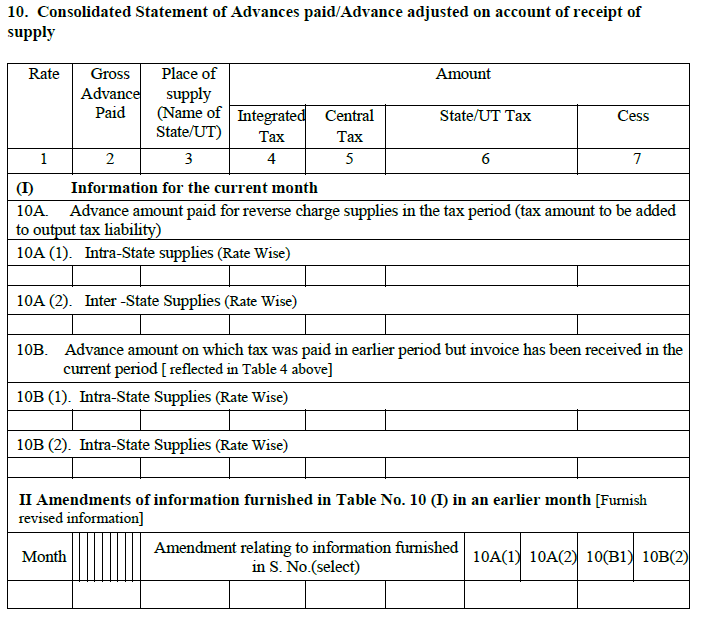
Part II will contain changes to above part I in relation to an earlier month.
11.Input Tax Credit Reversal / Reclaim –
ITC can be availed only on goods and services for business purposes. If they are used for non-business (personal) purposes, or for making exempt supplies ITC cannot be claimed. In this heading, the taxpayer must fill in details of ITC that cannot be claimed during the month due to various ITC rules.
11A. This head will cover all input tax reversal for the current month. It will also include ITC reversal on account of exempt and personal supplies.
a. Amount in terms of rule 37(2)– ITC will be reversed for invoices which were not paid within 180 days of issue.
b. Amount in terms of rule 39(1)(j)(ii)– This is for ISDs. If a credit note was issued by the seller to the HO then the ITC subsequently reduced will be reversed.
c. Amount in terms of rule 42(1)(m)– This is for businesses which use inputs for both business and non-business (personal) purposes. ITC used in the portion of input goods/services used for personal purpose must be reversed proportionately.
d. Amount in terms of rule 43(1)(h)– This is similar to above except that it concerns capital goods.
e. Amount in terms of rule 42 (2)(a)– This is calculated after the annual return is furnished. If total ITC on inputs of exempted/non-business purpose is more than the ITC actually reversed during the year then the difference amount will be added to output liability. Interest will be applicable.
f. Amount in terms of rule 42(2)(b)– This is the opposite of the above. If total ITC on inputs of exempted/non-business purpose is less than the ITC actually reversed during the year then the difference amount can be reclaimed as ITC.
Read our article on Reversal of Input Tax Credit to understand this in detail.
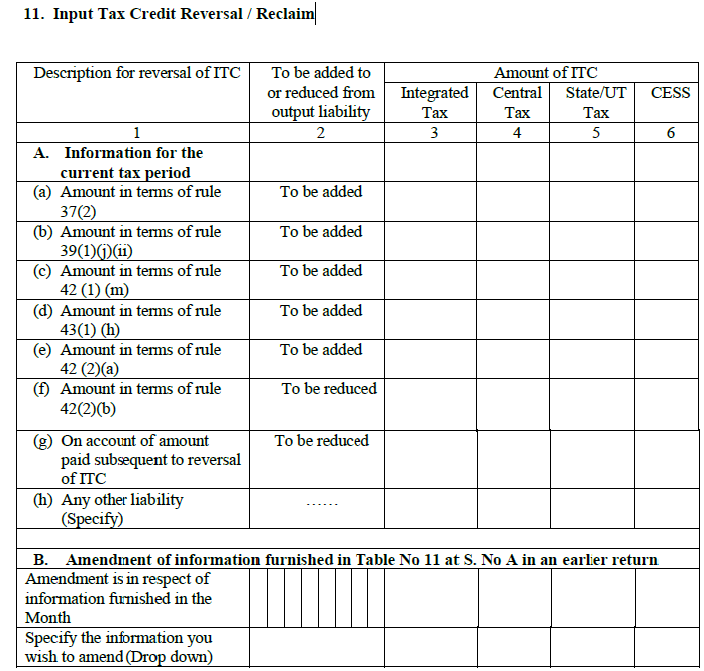
11B. The taxpayer can manually amend any details of ITC under 11A of earlier months. He will select the appropriate information from a drop-down menu.
12.Addition and reduction of amount of output tax for mismatch and other reasons –
This section will capture any additional tax liability that can arise due to the corrections made to the GSTR-3 of the previous month.
a) ITC claimed on mismatched/duplication of invoices/debit notes: In case mismatch of invoices, there may be double claiming of ITC. The excess ITC claimed from duplicate purchase invoices will be reversed and added to the tax liability.
b) Tax liability on mismatched credit notes: Incorrect credit notes issued by the taxpayer will also result in incorrect ITC. Extra ITC claimed due to mismatch will now be added to your tax liability.
c) Reclaim on account of rectification of mismatched invoices/debit notes: This is the opposite of point (a). In this case, the mismatch has led to claiming lower ITC. You are entitled to more ITC and so the additional amount will be reduced from the output tax liability.
d) Reclaim on account of rectification of mismatched credit note (Reduce): This is opposite to (b), i.e., lower ITC has been claimed and will work in the same way as (c).
e) Negative tax liability from previous tax periods:This is due to excess tax paid during the previous months and will be reduced from output tax liability of this month.
f) Tax paid in advance in earlier tax periods and adjusted with tax on supplies made in the current tax period (Reduce): This refers to tax paid along with advance payments in earlier months for supplies received during this month.

13.HSN summary of inward supplies – This section requires a registered dealer to provide HSN wise summary of goods purchased. It will be entered by the taxpayer.Finally, sign off with a declaration that all information has been declared and is correct.

Related Articles
How to view or access GSTR-2A on the GST portal?
Steps to view GSTR-2B from the GST portal



